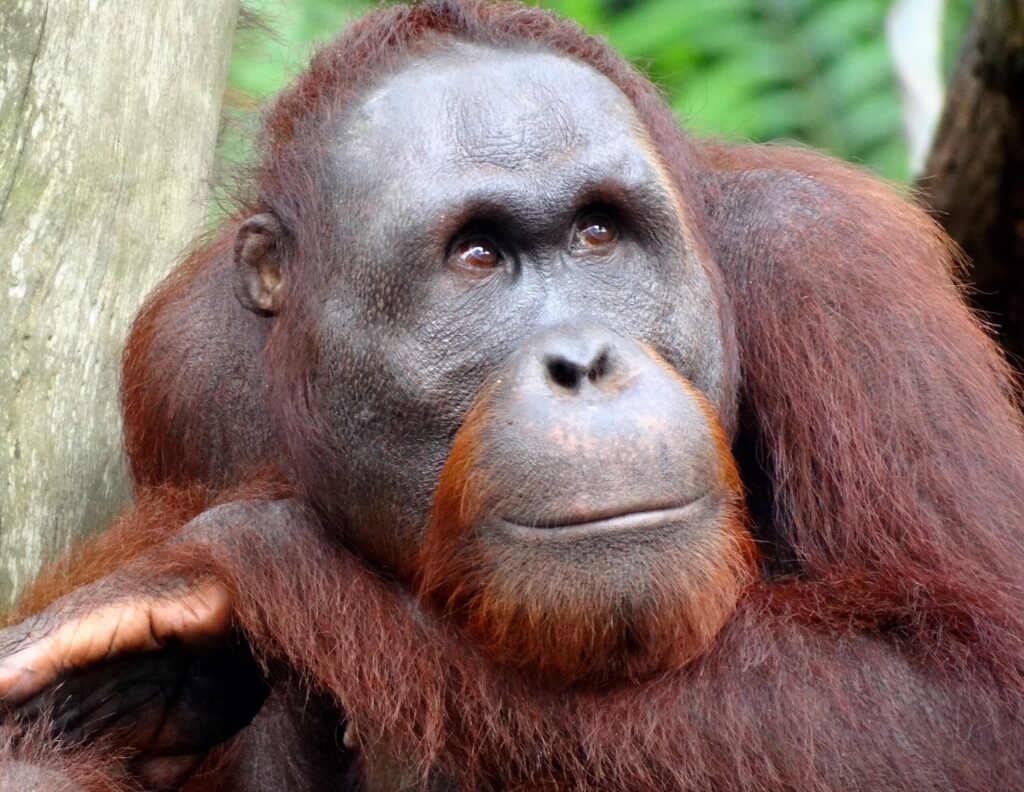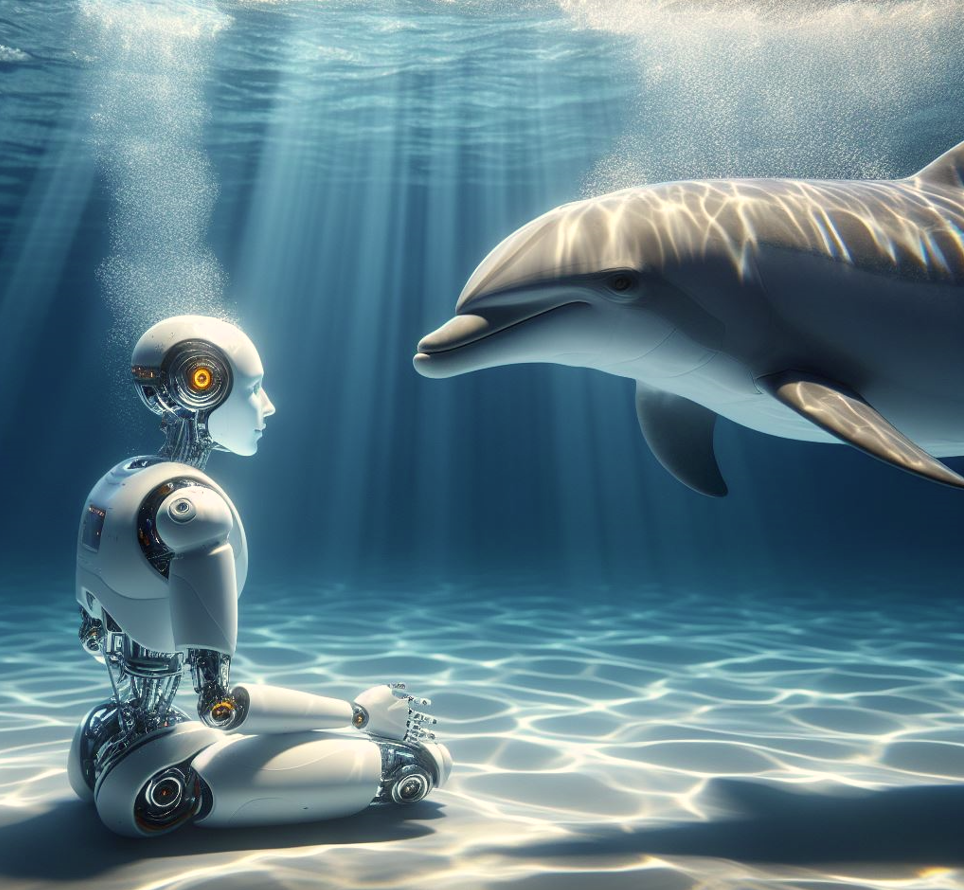
Imagine being able to understand what your cat is saying – literally. Image generated using Ideogram AI.
By Mariana Meneses
On Earth, the threads of communication weave intricate patterns for many species, forming a tapestry of voices that extend far beyond our own.
From the primal calls of the jungle animals to the melodious whale songs of the deep sea, the languages of non-human creatures echo with mysteries waiting to be unraveled. As humans, we often ponder: What do these voices say? What stories do they tell? And perhaps most profoundly, what would we learn if we could understand them?
In a recent TQR article, we discussed how AI is revolutionizing our comprehension of other species , with the powerful observation from the Earth Species Project that “More than 8 million species share our planet. We only understand the language of one.” Science and technology are advancing rapidly in this blossoming field, leading to recent discoveries such as the connection between orangutan calls and human language.
New Scientist recently reported on research led by Adriano Lameira, from the Department of Psychology at University of Warwick, that provides intriguing insights into the communication of Bornean orangutans.

Imagine the complexities of other species’ thoughts and languages that we currently ignore. Picture of a seemingly reflexive orangutan. Image: Bjørn Christian Tørrissen
By studying their long calls, primarily made by mature males to attract females, Lameira and his team uncovered a complex structure reminiscent of human language.
These calls exhibit a form of recursion, where shorter sequences are nested within longer ones, mirroring the construction of complex sentences in human speech.
What’s recursion? For an example, consider the sentence, “The TQR article that I read, which was recommended by my friend, is fascinating.” In this sentence, the relative clause “which was recommended by my friend” is embedded within the main clause “The article is fascinating.” This creates a recursive structure where one clause contains another.
This discovery challenges previous beliefs that recursion is unique to human language, and highlights the potential for evolutionary precursors in the linguistic abilities of other species. However, while the orangutan calls demonstrate structural complexity, there’s no evidence yet of encoded meanings within them. This suggests that recursion in animal communication might serve purposes similar to elaborate birdsong displays, such as signaling reproductive fitness, rather than conveying nuanced messages.
Nonetheless, this finding prompts further exploration into the communication systems of other animal species, offering valuable insights into the evolution of language and cognition.
However, understanding what they are saying is only part of what is needed to establish interspecies communication.
In the popular animated series Rick and Morty, understanding other species’ communications can be developed using a technological apparatus that looks like a headphone with an antenna. However, what Morty soon learns is that he hadn’t anticipated the implications of opening not a window for interspecies communication, but instead only a way to eavesdrop on others’ conversations.
Loss of privacy can be quite sensitive for any species, as we learn from how the squirrels unite to persecute Morty until he eventually flees that universe.

“Rick and Morty” is a widely acclaimed animated science fiction sitcom created by Dan Harmon and Justin Roiland. The show, known for its satirical humor and complex storytelling, premiered in 2013 and has garnered significant popularity, spanning seven seasons to date. Image: screenshot from season 3 episode “Morty’s Mind Blowers”. Credit: PrimaSoul via Reddit
So, where are we in the process of being able to talk with animals?
As you may expect, AI has been helping scientists with that. According to Deutsche Welle, scientists are utilizing AI tools to analyze and decode complex vocalizations across various species, from rodents to dolphins, revealing intricate patterns and behaviors previously inaccessible to human perception.
These tools, like DeepSqueak: a deep learning-based system for detection and analysis of ultrasonic vocalizations, enable researchers to automate the analysis of vast amounts of audio data, saving time and providing insights into animal behavior, emotions, and even health.

“Artist’s view showing an artificial intelligence learning to communicate with a dolphin, via an underwater robot”. Image: Lamiot.
While animals communicate through various means such as vocalizations, scents, and behaviours, debate continues on whether they possess anything approaching the complexity of meaning in human languages.
However, the increasing recognition of sophistication in animal communications challenges established notions of simplicity, suggesting that AI-facilitated research may not only deepen our understanding of the animal kingdom but also reshape our relationship with other living species, ultimately aiding in biodiversity conservation efforts.
In an interview for The Guardian, Dr. Arik Kershenbaum, a zoologist at Cambridge University, delves into the intricacies of animal communication, challenging common perceptions and shedding light on fascinating discoveries. Through his fieldwork with wolves, gibbons, and dolphins, Dr. Kershenbaum highlights the challenges of observing animal communication in the wild, emphasizing the necessity of innovative techniques such as passive acoustic localization. He discusses intriguing findings, including dolphins’ use of signature whistles akin to names, and parrots’ complex vocalizations, suggesting diverse communication strategies across species.
Dr. Kershenbaum challenges the notion that language defines human superiority, instead emphasizing the uniqueness of each species’ adaptations to their environment. Additionally, he speculates on the likelihood of humans conversing with intelligent aliens, highlighting the potential for communication even across vast evolutionary gaps.

What will happen once we can talk to animals? Image: World Animal Foundation
If humans could talk to animals, it could revolutionize our relationship with nature.
This could enhance our comprehension of animal intelligence and consciousness, potentially altering how we treat them, particularly in food production. It might also challenge our human-centric worldview.
Moreover, communication with animals could offer fresh insights into the natural world, benefiting fields like biology and ecology, and inspiring technological innovation. Ultimately, this ability could fundamentally change our understanding of the world, fostering a stronger sense of interconnectedness between humans and other living beings.

Will we make more friends or foes, once we can talk to animals? Image generated using Ideogram AI.
To paraphrase John Lennon:
“Imagine all the species living life in peace… You may say I’m a dreamer, but I’m not the only one. I hope someday you’ll join us, and the world will be as one.”
Craving more information? Check out these recommended TQR articles:
- Breaking the Language Barrier: AI’s Multilingual Future May Change How We Understand Our Present and Past
- Before We Move Out: Life Outside Earth Could Feature French Fries and Blood Deficiencies
- Magnetic Mysteries Beyond Our Solar System Could Help Us Find Life Out There
- Searching for Aliens: Scientific Rigor in the Pursuit of Extraterrestrial Life



